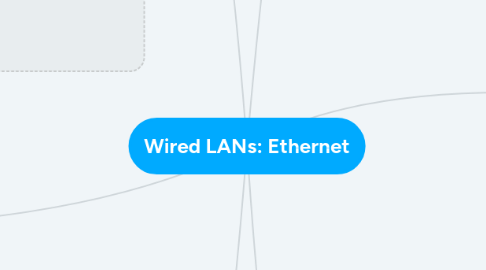
1. Fast Ethernet
1.1. MAC Sublayer
1.1.1. (half duplex with CSMA/CD) autonegotiation that allows two devices to negotiate the mode or data rate of operation.
1.2. Physical Layer
1.2.1. Reconciliation Sublayer (RS)
1.2.1.1. replaces the PLS sublayer in 10Mbps Ethernet
1.2.2. Medium-Independent Interface (MII)
1.2.2.1. replaces AUI in 10Mbps
1.2.3. PHY Sublayer
1.2.3.1. the transceiver in fast Ethernet responsible for encoding and decoding
1.2.4. Medium-Dependent Interface (MDI)
1.2.4.1. hardware
1.3. Physical Layer Implementation
1.3.1. 100Base-TX
1.3.1.1. uses 2 pairs of twisted cable in a physical star topology
1.3.2. 100Base-FX
1.3.2.1. uses 2 pairs of fiber-optic cable in a physical star topology
1.3.3. 100Base-T4
1.3.3.1. uses 4 pairs of UTP for transmitting 100 Mbps
2. Gigabit Ethernet
2.1. MAC Sublayer
2.1.1. half-duplex using CSMA/CD / full-duplex without CSMA/CD (no collision)
2.2. Physical Layer
2.2.1. Reconciliation Sublayer (RS)
2.2.1.1. sends 8 bit parallel data to the PHY sublayer via GMII interface
2.2.2. Gigabit Medium Independent Interface (GMII)
2.2.2.1. defines how the RS is to be connected to the PHYS sublayer
2.2.3. PHY Sublayer
2.2.3.1. transceiver that medium-dependent
2.2.4. Medium Dependent Interface (MDI)
2.2.4.1. hardware
2.3. Physical Layer Implementation
2.3.1. 1000Base-SX
2.3.1.1. two-wire short-wave fiber
2.3.2. 1000Base-LX
2.3.2.1. two-wire long-wave fiber
2.3.3. 1000Base-CX
2.3.3.1. two-wire copper (STP)
2.3.4. 1000Base-T
2.3.4.1. Four-wire UTP
3. Ten-Gigabit Ethernet
3.1. MAC Sublayer
3.1.1. operates only in full duplex mode (not used CSMA/CD)
3.2. Physical Layer
3.2.1. designed for using fiber-optic cable over long distance
3.3. Physical Layer Implementation
3.3.1. 10G-BaseTX
3.3.1.1. Short-wave 850-nm multimode
3.3.2. 10G-BaseFX
3.3.2.1. Long-wave 1310-nm single mode
3.3.3. 10G-BaseT4
3.3.3.1. Extended 1550-nm single mode
4. IEEE Standard
4.1. Data Link Layer
4.1.1. Logical Link Control (LLC)
4.1.1.1. responsible for the flow control, error control, and part of the framing duties
4.1.2. Media Access Control (MAC)
4.1.2.1. responsible for the operation of the CSMA/CD method and framing.
4.2. Physical layer
4.2.1. Physical Layer Signaling (PLS)
4.2.1.1. encodes and decodes data
4.2.2. Attachment Unit Interface (AUI)
4.2.2.1. defines the interfaces between the PLS and MAU
4.2.3. Medium Attachment Unit (MAU)
4.2.3.1. transmits signals, receive signals and detects collisions
4.2.4. Medium Dependent Interface (MDI)
4.2.4.1. hardware for connecting a transceiver to the medium
5. Standard Ethernet
5.1. MAC Sublayer
5.1.1. governs the operation of the access method.
5.1.2. Frame Format
5.1.2.1. contains seven fields: preamble, start frame delimiter (SFD), destination address (DA), source address (SA), length of protocol data unit (PDU), data and the CRC
5.1.3. Frame length
5.1.3.1. imposed restrictions on both the minimum(64 bytes) and maximum(1518 bytes) length of a frame.
5.1.4. Addressing
5.1.4.1. Each station on an Ethernet network has its own network interface card (NIC) that fits inside the station and provides the station with a 6-byte physical address.
5.1.4.2. Unicast Address
5.1.4.2.1. defines only one recipient (1to1)
5.1.4.3. Multicast Address
5.1.4.3.1. defines a group of addresses (1to many)
5.1.4.4. Broadcast Address
5.1.4.4.1. a special case of multicast address (all stations on the network)
5.2. Physical Layer Implementation
5.2.1. 10Base5 (Thick Ethernet)
5.2.1.1. uses bus topology w/ external transceiver connected via a tap to a thick coaxial cable
5.2.2. 10Base2 (Thin Ethernet)
5.2.2.1. uses bus topology w/ internal transceiver / point-to-point connection via an external receiver
5.2.3. 10Base-T (Twisted-Pair Ethernet)
5.2.3.1. uses physical star topology w/ internal / external transceiver connected to a hub
5.2.4. 10Base-F (Fiber Link Ethernet)
5.2.4.1. uses a star topology to connect stations to a hub
6. Standard Ethernet Evolution
6.1. Bridge Ethernet
6.1.1. divides the network into two or more networks to gain more bandwidth for each segment
6.2. Switched Ethernet
6.2.1. bandwidth is shared only between the station and the switch
6.3. Full-Duplex Ethernet
6.3.1. can either send or receive data at the same time simultaneously
